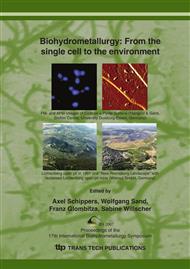p.547
p.551
p.557
p.561
p.565
p.571
p.572
p.573
p.574
The Use of CARD-FISH to Evaluate the Quantitative Microbial Ecology Involved in the Continuous Bioleaching of a Cobaltiferrous Pyrite
Abstract:
Catalyzed reporter deposition fluorescence in situ hybridization (CARD-FISH) is a powerful method with a growing number of applications in the quantitative evaluation of microbial populations of complex ecosystems. CARD-FISH is an improvement over traditional fluorescence in situ hybridization (FISH) especially suitable for aquatic habitats with small, slow growing, or starving bacteria, in which the signal intensities of hybridized cells is frequently below detection limits or lost in high fluorescence background of dense mineral matrixes. In this work we report the development of protocols and probes for the identification and quantification of the microorganisms involved in the continuous bioleaching of a cobaltiferrous concentrate using a four tank-leaching reactor operated by BRGM. After steady state was reached, samples were taken to identify and quantify the microorganisms present in the each of the tanks used in the process.
Info:
Periodical:
Pages:
565-568
Citation:
Online since:
July 2007
Authors:
Price:
Сopyright:
© 2007 Trans Tech Publications Ltd. All Rights Reserved
Share:
Citation:


